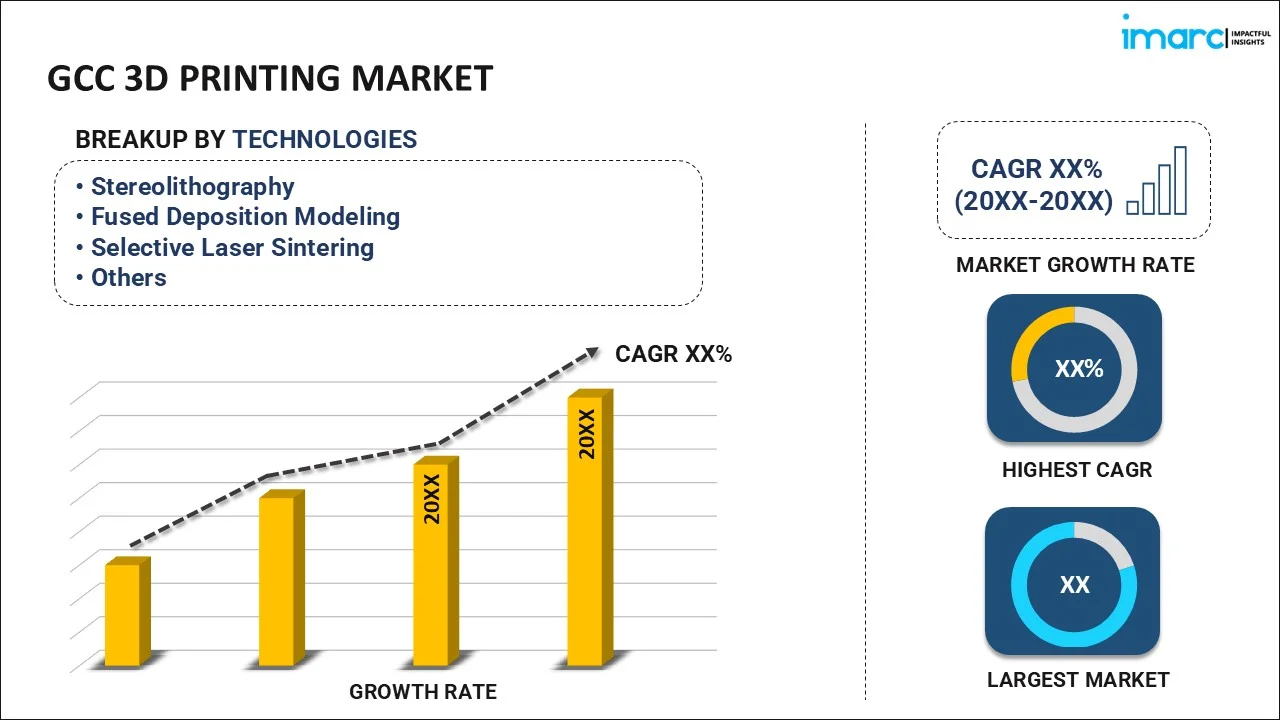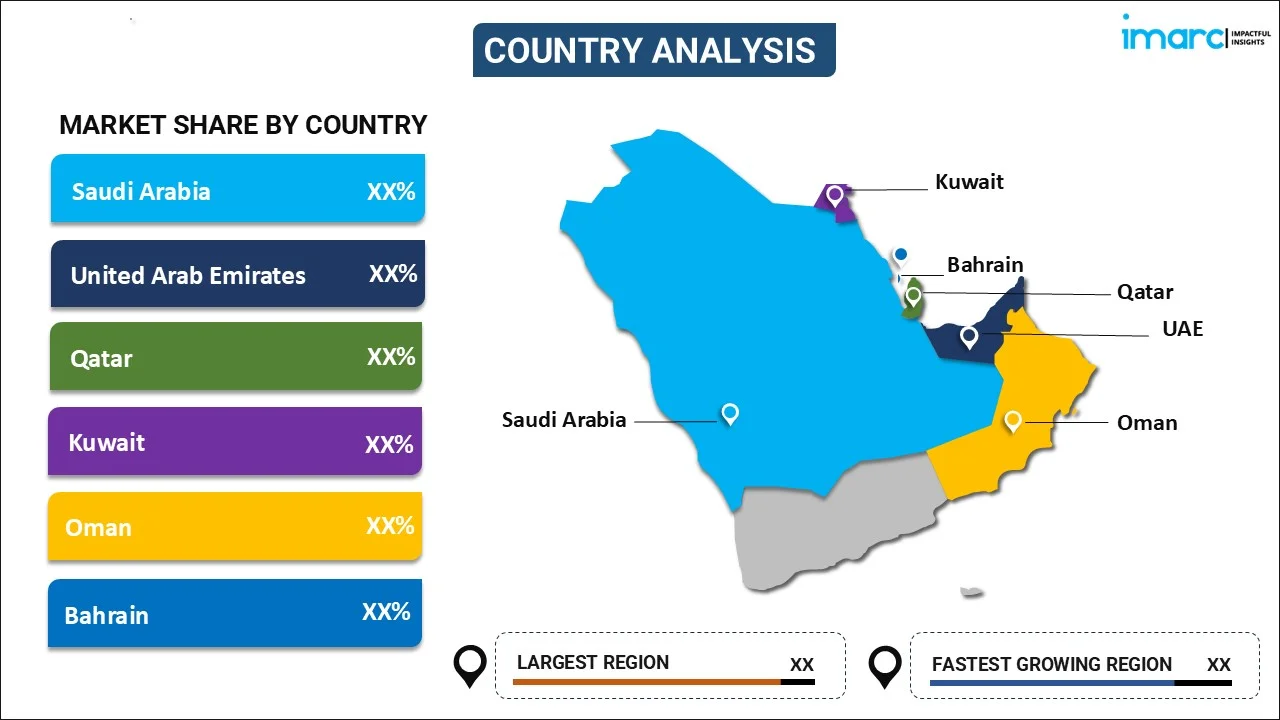
GCC 3D Printing Market Report by Technology (Stereolithography, Fused Deposition Modeling, Selective Laser Sintering, Electron Beam Melting, Digital Light Processing, and Others), Process (Binder Jetting, Directed Energy Deposition, Material Extrusion, Material Jetting, Power Bed Fusion, Sheet Lamination, Vat Photopolymerization), Material (Photopolymers, Plastics, Metals and Ceramics, and Others), Offering (Printer, Material, Software, Service), Application (Prototyping, Tooling, Functional Part Manufacturing), End User (Consumer Products, Machinery, Healthcare, Aerospace, Automobile, and Others), and Country 2025-2033
Market Overview:
The GCC 3D printing market size reached USD 542.0 Million in 2024. Looking forward, IMARC Group expects the market to reach USD 3,056.0 Million by 2033, exhibiting a growth rate (CAGR) of 20.6% during 2025-2033. The widespread technology adoption in the healthcare industry, favorable government initiatives, growing demand for customization and personalization, and the integration of digital technologies such as the Internet of Things (IoT), artificial intelligence (AI), and cloud computing represent some of the key factors driving the market.
|
Report Attribute
|
Key Statistics
|
|---|---|
|
Base Year
|
2024 |
|
Forecast Years
|
2025-2033
|
|
Historical Years
|
2019-2024
|
| Market Size in 2024 | USD 542.0 Million |
| Market Forecast in 2033 | USD 3,056.0 Million |
| Market Growth Rate (2025-2033) | 20.6% |
3D printing, also known as additive manufacturing, is a process of creating three-dimensional objects by layering or adding material together based on a digital design. It utilizes a range of materials, including plastics, metals, ceramics, resins, and even food and biological materials, depending on the specific 3D printing technology employed. Unlike traditional manufacturing processes that involve subtractive methods, 3D printing builds the object layer by layer, using materials such as plastics, metals, ceramics, and even biological substances. The process begins with a 3D model, which is sliced into thin layers, and the printer follows these layers' instructions to create the final product. The versatility and potential cost-saving benefits of 3D printing have revolutionized prototyping, product development, and small-scale manufacturing, opening new opportunities in industrial and consumer settings.
GCC 3D Printing Market Trends:
One of the key factors driving the GCC 3D printing market is the growing emphasis on promoting local manufacturing and reducing reliance on imports. 3D printing allows businesses to establish more agile and localized production capabilities, reducing supply chain complexities and lead times. In addition to this, the widespread technology adoption in the healthcare industry for patient-specific implants and prosthetics is favoring the market growth. Moreover, the GCC governments' initiatives and investments in research and development (R&D) have fostered a supportive ecosystem for the growth of additive manufacturing. They are recognizing 3D printing's potential to drive economic diversification and job creation, encouraging both public and private entities to invest in the technology, which is creating a positive outlook for the market. Apart from this, rapid technological advancements, and continuous improvements in 3D printing technologies, such as enhanced printing speed, accuracy, and material options, are providing a considerable boost to the market growth. Furthermore, the widespread adoption of 3D printing in businesses helps in the creation of complex and customized products quickly and cost-effectively, which is contributing to the market growth. Besides this, the rising demand for 3D printing, as it allows rapid prototyping and iteration in product development cycles and enables designers and engineers to create physical prototypes quickly and test designs, is positively influencing the market growth. Other factors, including growing demand for customization and personalization, increasing focus on sustainable practices, ongoing research and development (R&D) in 3D printing, widespread adoption in educational institutions and research labs, and integration of digital technologies such as the Internet of Things (IoT), artificial intelligence (AI), and cloud computing are supporting the market growth.
Market Segmentation:
IMARC Group provides an analysis of the key trends in each segment of the GCC 3D printing market report, along with forecasts at the regional and country levels for 2025-2033. Our report has categorized the market based on technology, process, material, offering, application, and end user.
Technology Insights:

- Stereolithography
- Fused Deposition Modeling
- Selective Laser Sintering
- Electron Beam Melting
- Digital Light Processing
- Others
The report has provided a detailed breakup and analysis of the market based on technology. This includes stereolithography, fused deposition modeling, selective laser sintering, electron beam melting, digital light processing, and others.
Process Insights:
- Binder Jetting
- Directed Energy Deposition
- Material Extrusion
- Material Jetting
- Power Bed Fusion
- Sheet Lamination
- Vat Photopolymerization
A detailed breakup and analysis of the market based on the process has also been provided in the report. This includes binder jetting, directed energy deposition, material extrusion, material jetting, power bed fusion, sheet lamination, and vat photopolymerization.
Material Insights:
- Photopolymers
- Plastics
- Metals and Ceramics
- Others
A detailed breakup and analysis of the market based on the material has also been provided in the report. This includes photopolymers, plastics, metals and ceramics, and others.
Offering Insights:
- Printer
- Material
- Software
- Service
A detailed breakup and analysis of the market based on the offering has also been provided in the report. This includes printer, material, software, and service.
Application Insights:
- Prototyping
- Tooling
- Functional Part Manufacturing
A detailed breakup and analysis of the market based on the application has also been provided in the report. This includes prototyping, tooling, and functional part manufacturing.
End User Insights:
- Consumer Products
- Machinery
- Healthcare
- Aerospace
- Automobile
- Others
A detailed breakup and analysis of the market based on the end user has also been provided in the report. This includes consumer products, machinery, healthcare, aerospace, automobile, and others.
Country Insights:

- Saudi Arabia
- UAE
- Qatar
- Bahrain
- Kuwait
- Oman
The report has also provided a comprehensive analysis of all the major regional markets, which include Saudi Arabia, UAE, Qatar, Bahrain, Kuwait, and Oman.
Competitive Landscape:
The report has also provided a comprehensive analysis of the competitive landscape in the market. Competitive analysis such as market structure, key player positioning, top winning strategies, competitive dashboard, and company evaluation quadrant has been covered in the report. Also, detailed profiles of all major companies have been provided.
GCC 3D Printing Market Report Coverage:
| Report Features | Details |
|---|---|
| Base Year of the Analysis | 2024 |
| Historical Period | 2019-2024 |
| Forecast Period | 2025-2033 |
| Units | Million USD |
| Scope of the Report | Exploration of Historical and Forecast Trends, Industry Catalysts and Challenges, Segment-Wise Historical and Predictive Market Assessment:
|
| Technologies Covered | Stereolithography, Fused Deposition Modeling, Selective Laser Sintering, Electron Beam Melting, Digital Light Processing, Others |
| Processes Covered | Binder Jetting, Directed Energy Deposition, Material Extrusion, Material Jetting, Power Bed Fusion, Sheet Lamination, Vat Photopolymerization |
| Materials Covered | Photopolymers, Plastics, Metals and Ceramics, Others |
| Offerings Covered | Printer, Material, Software, Service |
| Applications Covered | Prototyping, Tooling, Functional Part Manufacturing |
| End Users Covered | Consumer Products, Machinery, Healthcare, Aerospace, Automobile, Others |
| Countries Covered | Saudi Arabia, UAE, Qatar, Bahrain, Kuwait, Oman |
| Customization Scope | 10% Free Customization |
| Post-Sale Analyst Support | 10-12 Weeks |
| Delivery Format | PDF and Excel through Email (We can also provide the editable version of the report in PPT/Word format on special request) |
Key Questions Answered in This Report:
- How has the GCC 3D printing market performed so far and how will it perform in the coming years?
- What has been the impact of COVID-19 on the GCC 3D printing market?
- What is the breakup of the GCC 3D printing market on the basis of technology?
- What is the breakup of the GCC 3D printing market on the basis of process?
- What is the breakup of the GCC 3D printing market on the basis of material?
- What is the breakup of the GCC 3D printing market on the basis of offering?
- What is the breakup of the GCC 3D printing market on the basis of application?
- What is the breakup of the GCC 3D printing market on the basis of end user?
- What are the various stages in the value chain of the GCC 3D printing market?
- What are the key driving factors and challenges in the GCC 3D printing market?
- What is the structure of the GCC 3D printing market and who are the key players?
- What is the degree of competition in the GCC 3D printing market?
Key Benefits for Stakeholders:
- IMARC’s report offers a comprehensive quantitative analysis of various market segments, historical and current market trends, market forecasts, and dynamics of the GCC 3D printing market from 2019-2033.
- The research study provides the latest information on the market drivers, challenges, and opportunities in the GCC 3D printing market.
- Porter's five forces analysis assist stakeholders in assessing the impact of new entrants, competitive rivalry, supplier power, buyer power, and the threat of substitution. It helps stakeholders to analyze the level of competition within the GCC 3D printing industry and its attractiveness.
- Competitive landscape allows stakeholders to understand their competitive environment and provides an insight into the current positions of key players in the market.
Need more help?
- Speak to our experienced analysts for insights on the current market scenarios.
- Include additional segments and countries to customize the report as per your requirement.
- Gain an unparalleled competitive advantage in your domain by understanding how to utilize the report and positively impacting your operations and revenue.
- For further assistance, please connect with our analysts.
 Inquire Before Buying
Inquire Before Buying
 Speak to an Analyst
Speak to an Analyst
 Request Brochure
Request Brochure
 Request Customization
Request Customization




.webp)




.webp)












